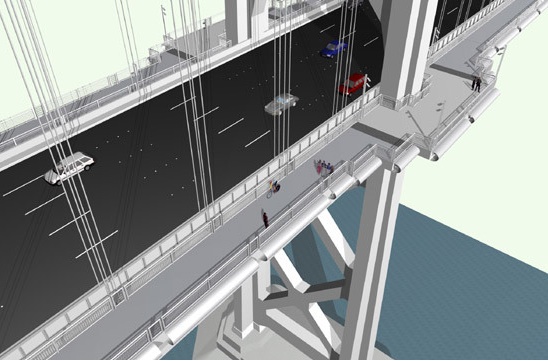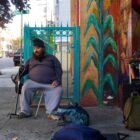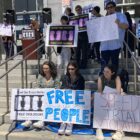While the Bay Area Toll Authority met on Wednesday morning to vote on Bay Area bridge toll increases, dozens of bicycle activists demonstrated support for the building of a bicycle and pedestrian pathway addition to the Bay Bridge’s western span. They are pressing bridge officials to pave the way for a cross-bay bike lane.
The meeting was held to vote on what amounts to a batch of toll increases on state-owned Bay Area bridges, and the introduction of peak-hour and congestion pricing on the Bay Bridge, where the toll will be $6 during weekday commute hours, $5 on weekends and $4 on weekdays during off-peak hours.*
Several different toll hikes were approved — most unanimously — and in July drivers crossing most Bay Area bridges will have to pay $5. Carpoolers will swap their free ride for a less attractive discounted $2.50 toll. Revenue from the increases will mostly be used to fund seismic retrofits of the Dumbarton and Antioch bridges.
Construction of the pathway, which could double as a maintenance and safety shoulder, remains hung up in a bureaucratic no-man’s land: it has garnered some public support, but it is not clear who has legislative power to funnel toll revenue to new projects, or from where.
The first 30 minutes of the morning meeting were dominated by the activists, who spilled out of the aisles at the MetroCenter auditorium in Oakland. Some jeered, and others waved homespun signs that read, “All the way across the Bay,” and “East span is not a bridge to nowhere.”
Among those who gave minute-long public testimony, roughly half expressed strong support for the pathway. They cited concerns including opening the East Bay to bicycling tourists, increasing seismic and motorist safety and transportation options for future Treasure Island residents.
Members of the board of the Bay Area Toll Authority deflected the issue as a matter of fund allocation and legislation.
After admonishing the swelling crowd for blocking fire exits, Chairman Scott Haggerty was determined to discuss other matters.
“Not that there is or there isn’t support for the bike lane, but that topic is not germane to today’s discussion,” Haggerty said. “We are talking about the [toll] increase.”
Berkeley Mayor Tom Bates, a member of the board, expressed support, but called the prospect of getting support from the agency for a west span bike path “unfeasible.” He urged those present to take their case to the state.
But state support waned and gave way to concern over massive cost overruns on the east span. Rayburn was not surprised to see the Bay Area Toll Authority and its parent, the Metropolitan Transportation Commission, refuse to entertain measures to move funds from toll revenues to a pathway project.
The Bay Area Toll Authority, Rayburn said, has “given us a clear indication that they were not going to entertain a motion on behalf of bikes. I had hoped that they would have adopted a modified congestion pricing fee that could have built the revenue for the path.”
“But we were very pleased to hear Tom Bates’ leadership,” Rayburn added. “Now he is pushing for legislation in Sacramento that will give very clear direction to the MTC that they can spend money on completing the path.”
Bates and the Berkeley City Council passed a resolution on Jan. 19 calling for the toll authority to use new toll revenue to fund a new pathway. In addition, he has advocated moving the debate to Sacramento, where the issue of authority can be resolved.
Marc Caswell, a program manager with the San Francisco Bicycle Coalition, pleaded with toll authority to do that.
“There is lack of clarity around the legislative authority over the ability to do this,” Caswell said. “I want to make sure that we have your support when we possibly go to the Legislature for this. We urge you to plan ahead.”
But the bicycle advocates got little encouragement from the board.
“There are many different allies,” Rayburn said. “It does come down to money.”
* Updated at 5:45 p.m. This story was updated to correct the spelling of Robert Rayburn, director of the East Bay Bicycle Coalition.










